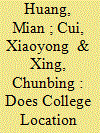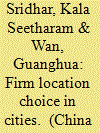|
|
|
Sort Order |
|
|
|
Items / Page
|
|
|
|
|
|
|
| Srl | Item |
| 1 |
ID:
106008


|
|
|
|
|
| Publication |
2011.
|
| Summary/Abstract |
Chinese outward direct investment (ODI) appears to differ from that of advanced economies. Is there a unique China model? By reviewing industry distributions of ODI data for 2003-2009, we found that Chinese ODI was not concentrated in industries that performed well either in exporting or domestically. Statistical analyses also confirmed that traditional variables, such as market size, production cost and legal environment, did not impact Chinese investors' choice of location for ODI. Instead, investors selected places where they could either learn advanced technologies or secure stable commodity supplies. We have tentatively concluded that the main purpose of the China model of ODI has not been to expand production overseas but to strengthen industries at home.
|
|
|
|
|
|
|
|
|
|
|
|
|
|
|
|
| 2 |
ID:
186223


|
|
|
|
|
| Summary/Abstract |
Based on a representative survey of new college graduates in China, we present a job location choice model that allows for a self-selection effect in college regions by considering region-dependent heterogeneous preference for job locations and unobservable location features. We also treat endogenous housing costs using the method developed by Berry et al. (1995). Our estimation results show that college education significantly increases graduates' likelihood of working in the city where their college is located. However, a model that does not consider the self-selection effect overestimates this impact. The impact of college location on a graduate's migration decision varies considerably across cities. There is significant heterogeneity between students from universities of different tiers and rural versus urban areas. Meanwhile, the graduates show a marked home preference when choosing their job locations, and they tend to avoid working in cities with high housing costs. These findings shed light on debates on place-based higher education policies and spatial distribution of human capital with a high level of education.
|
|
|
|
|
|
|
|
|
|
|
|
|
|
|
|
| 3 |
ID:
093846


|
|
|
|
|
| Publication |
2010.
|
| Summary/Abstract |
This paper contributes to the industrial location literature by examining why industry locates or refrains from locating in large, medium and small cities of India, China and Brazil using firm-level data from the World Bank. Results from ordered logistic regressions indicate that capital cities are not attractive for firms to locate, when they are large. In India and China, labor intensive firms do not locate in large cities. Proximity to inputs has a positive impact on firm location in China. While availability of inputs has a positive impact on firm location in India, the availability of raw materials has a negative impact on firm location in Brazil. Firms established in post-reform period in India tend to locate in large cities; in China, these firms avoid medium and large cities. The implications for urban governance in these countries are discussed.
|
|
|
|
|
|
|
|
|
|
|
|
|
|
|
|
| 4 |
ID:
178729


|
|
|
|
|
| Summary/Abstract |
Does terrorism inhibit a country’s ability to attract international direct investment? If so, terrorism may have large costs in terms of employment losses, macroeconomic instability, and missed development opportunities. However, do investors fear terrorism because of direct risks to their assets, or because the opportunities in the host country deteriorate? And how do they adjust investments? We study the impact of terrorism on merger and acquisition decisions of 8,872 firms over 116 countries over 16 years. The firm-level perspective allows the isolation of host-country terrorism from firm-level characteristics such as size or experience as an explanation, by comparing decisions for the same firm across destinations. It also allows separation of investment responses into reductions or entire withholding of investment. A sample standard deviation increase in terrorism reduces merger and acquisition investment by around 30%. Firms do not generally reduce the size of their investment in the face of terrorism – instead, they decide not to enter the country altogether. We find no evidence to suggest that multinational firms are more sensitive to attacks on local business assets. A country-level analysis, which necessarily does not control for firm-level characteristics, yields materially different conclusions.
|
|
|
|
|
|
|
|
|
|
|
|
|
|
|
|
| 5 |
ID:
079937


|
|
|
|
|
| Publication |
2007.
|
| Summary/Abstract |
In this paper we re-examine the regional determinants of FDI in China using both total FDI flows, and FDI flows disaggregated by entry mode. Building on both the FDI location and entry mode choice literatures, we argue for the existence of mode-specific location advantages, and test for their existence. We first specify and estimate a location model of aggregate FDI flows to Chinese regions. Using the aggregate model as a benchmark, we then estimate separate equations for each of three different entry modes (wholly-owned subsidiaries, equity joint ventures and cooperative joint ventures), and compare the results with the aggregate model. The results indicate that mode-specific location advantages do exist, at least within China, but they are limited to a small number of factors. In particular, we identify the accumulated stock of FDI as being more likely to attract high control modes of entry, while existing policies to attract FDI are more likely to attract lower control modes of entry.
|
|
|
|
|
|
|
|
|
|
|
|
|
|
|
|
|
|
|
|
|